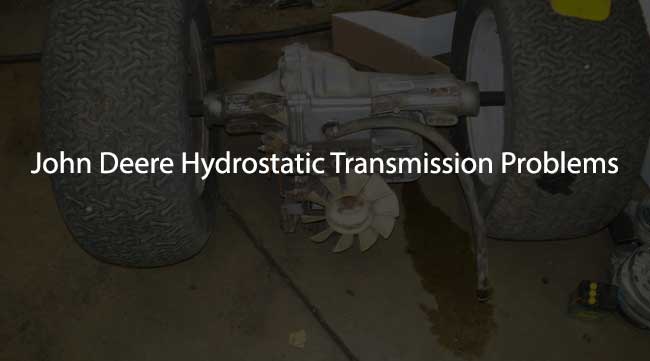John Deere is worldly used by agriculture sectors, but it’s a matter of regret that it has many issues.
Today we will discuss the top John Deere Hydrostatic transmission problems and solutions.
Its high power acceleration system and powerful dynamic abilities are the main reason behind its popularity.
Hydrostatic transmission problems are found in lawnmowers, tractors, cars, water motors, and many more machinery vehicles.
PetersonBrosAutomation helped us to understand how a hydrostatic transmission works; watch it here,
Today we are gonna talk about the John Deere Hydrostatic transmission problems and their possible solutions, which will help you out with your old problem.
John Deere Hydrostatic transmission problems and solutions in 2022
Every Combustion engine that uses the Deere Hydrostatic transmission system faces various issues.
A hydrostatic motor may not work due to troubleshooting problems like having a poor drive belt, broken spring, lacking essential fuels, overheated engine oil and hydraulic fluid, dust, and air in the hydraulic system, and more troubleshooting errors.
Let’s find out below,

Check your Pump Belt
You need to check the connection first; If the connection is loose or broken, the motor will never work.
The belt could be old or broken due to heat or over-usage. When we use the pump, friction is created regularly. So the pump belt could be torn and broken.
Air and Dust in the Engine
Sometimes air and raindrops could create obstacles in the engines. This could be a problem while starting the motor.
Check the Engine oil.
Every motor and engine needs clear oils to run. Sometimes, we forget to change the engine oils or motor oils for ages.
If the oil is expired, dusted, cold, or overheated, your motor will be stopped working. After the over usage of the engine oil, the motor stops working.
Broken and Rusted Spring
As you know, there are lots of parts used in a John Deere Hydrostatic transmission system.
One is a broken and rusted spring, bulbs, nuts, and jacks. This usually slows down the system and then stops working eventually.
The spring can be broken due to usage. Sometimes, the spring could be rusted due to water and rain.
Hydraulic fuel
As it’s a hydraulic transmission that needs hydraulic fuel, one needs to check the fuel level regularly.
If it’s below the belt, the motor will never start.
If your system has any kind of transmission error or problems, you must check the level.
Sometimes, you need to check the thickness of the fuel also.
As sometimes it could be filled with dust and specks of dirt. The fule could be cold and could be hot. Both create problems with running.
Hosepipe issues
Hosepipe usages are used to cool the engine system.
For use over the years, there could be some problems like leakages and damages, spills, breaks down, and swellings issues.
Issues in Hydraulic Systems
Most engines and motors are exposed to the air when it’s working. There are so many specks of dust, dirt, grasses, and many more relevant-irrelevant particles.
This creates an obstacle to running the motor and the transmission system.
Non-Hydraulic Related Items
Except for the internal issues, there are some more issues you need to consider.
Battery, air filter, charging system, carburetor, poor engine system, unplugged engine system, and a few more issues.
There is a lifetime limit for every single thing in the world. If the engine is old, then it will create so many issues. You need to check every part of the engine and motor to run it with no lags.
There could be issues like leakage, old engine, and rusted motors that could create troubleshooting problems in the John Deere Hydrostatic transmission system.
Youtube Channel Credit: bcbloc02 John Deere 300/400 series Hydrostatic Transmission Teardown and Inspection [Watch now]
Solutions When there are some issues, there will be solutions. All the John Deere Hydrostatic transmission problems have some solutions if it is not dead. Let’s check what we can do now.
- Check the pump belt and spring, if it is okay or not. If it’s changeable, you can change them. Try to find the same and original parts.
- Check the engine fuel and gear oil. Change if it is thick and dusted change it immediately.
- Change the hydraulic oil if it’s overheated and cool, and dusted.
- Change the rusted spring, jack, and other parts and take care of them. Those parts are the tiniest but most powerful elements of the motor.
- If air is in the hydraulic system, try to resolve the issues; take expert opinions.
- Check the gearbox and engine regularly. Dust and rust could damage the gearbox and engine.
- After checking the oil reserve, fill it with oil immediately. Because without oil, the John Deere Hydrostatic transmission could not be used.
- The battery and the air filter should be checked regularly as it helps to keep the motor health good.
- Charge the battery regularly. If you do not charge it, the battery will be damaged.
- Do not keep the engine and battery idly. If you are not using the John Deere Hydrostatic transmission system for a long time, try to start with a certain period.
- Repair the hose pipe according to the issues. If the problem is mild, you can just repair it. But if there are the biggest issues like a hole, then take immediate action.
In case your tractor is not moving. I suggest you check the video from Buckwsr.
Top John Deere Hydrostatic transmission problems and solutions are discussed in this article. We tried to discuss overall problems.
We also shared some solutions. If you are not facing any problems mentioned above, you must check the motor and engine regularly.
At any time, you may face issues. It’s better to be careful before any issues or accidents. Keep necessary mower or tractor repair tools in your garage.
As these problems are not usually discussed and noticed, people might feel panicked when one of these issues arrives. Make sure you have the mechanics’ contact number in your phonebook.

Hi, This is George. Founder Of Vacuumist.com. Completed my graduation in Bachelor of Business Administration. Proud father of two lovely baby girls. Reviewing home appliances is my passion. Developing this blog to update and publish my recent reviews and research. Stay in touch.
